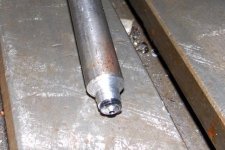metalmagpie
Titanium
- Joined
- May 22, 2006
- Location
- Seattle
My lathe has a lot of flat ball oilers. For example, the compound has 3 of them. Two on one end feed oil grooves underneath, to lubricate the compound moving on its ways, and the other one is in the middle, where it lubricates the lead screw. Of my two at one end, one has never seemed to pass any oil. Today I dug into it. I ran a sheet metal screw into the top and yanked it up with a claw hammer. This worked great and didn't seem to hurt the ball oiler any.
Then I wound the compound all the way out and pulled it loose so I could see the bottom. That's when I found out about the oil grooves. The weird thing is, when I dripped oil into the recess on top where the recalcitrant oiler goes, it ran through to the oil groove fine. And when I dripped oil into the ball oiler loose in my hand, the oil came right out the bottom. So I reinstalled it and dang it it didn't pass any oil again.
Can someone please explain to me how this can be and what's going on here?
metalmagpie
Then I wound the compound all the way out and pulled it loose so I could see the bottom. That's when I found out about the oil grooves. The weird thing is, when I dripped oil into the recess on top where the recalcitrant oiler goes, it ran through to the oil groove fine. And when I dripped oil into the ball oiler loose in my hand, the oil came right out the bottom. So I reinstalled it and dang it it didn't pass any oil again.
Can someone please explain to me how this can be and what's going on here?
metalmagpie






